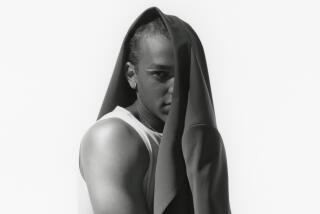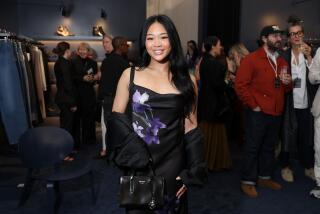Well-Suited : In the ‘90s, men have discovered discount shopping. That’s good news for off-price retailers, pinched by recession.
Chick Schneider is on a fashion mission at C&R; Clothiers. He fingers the racks of blue and gray suit jackets, eventually sliding his medium frame into a gray wool pin-stripe.
“My wife wants me to own at least one good suit,” he says. “She thinks I need one for all the bar mitzvahs and funerals we go to.”
A few years ago, Schneider might have purchased a shirt or a pair of slacks at a discount store, but never a suit. He says his buying habits have changed with the economy. No longer brand-conscious, what he looks for today is “something nice . . . and reasonably priced.”
Across town, at Marshall’s, Jeffrey Madden emerges from the dressing room in a print rayon shirt selling for $19 and silk shorts at $21. “I saw these same shorts at The Broadway for $42 last week,” he says.
Value drove many women shoppers to discounters during the 1980s. But in the 1990s, men have become the target audience of off-price stores. And with good reason. According to an industry survey, a majority of men refuse to spend more than $300 for slacks and a sport coat.
The typical male discount shopper, says Marshall’s spokeswoman Michelle Healy, is “short on time and trying to make the most of his money. He often shops with the whole family or with his children so efficiency is a big factor.”
Men who shop at discount stores also have more disposable income than people might imagine. According to Healy, the medium household income for a discount shopper has risen from $35,000 three years ago to $55,000 today.
“Basically, I shop specialty stores,” says Anthony Echendu, a physician, who bought six suits in the past year. Yet there he was at C&R; Clothiers earlier this week, enticed by commercials promising an additional 25% off its already discounted merchandise.
“Everyone wants a discount sometimes,” says Echendu, “especially when the economy isn’t getting any better.”
But do men really want to buy a suit--considered to be an executive calling card--at a discount store?
Zachary All Vice President Eddie Nalbandian says men will shop for suits at a discount store if they can find the brands they want and if the store carries a broad selection. In addition to a large private-label business, Zachary All carries suits by Botany 500, Cartier, Bert Pulitzer and Oleg Cassini. The average price is $160 to $320.
“The key to off-price shopping,” observes Healy, “is to shop frequently because the merchandise comes in a couple times a week and the turnover is very quick.” Some customers, she adds, check with store managers every week to find out when new shipments are coming in.
“On the West Coast, shoppers are exposed to a lot of different types of retail, including specialty and department stores, off-price and outlets,” says Healy. “So they’ve been conditioned to look for value.”
That situation has made bargains relatively easy to come by in Los Angeles. A shopper can find a $200 suit at Marshall’s, Zachary All, C&R;, Piller’s of Eagle Rock and other discount stores.
But even the discounters have been hit by trying financial times. At family-owned Zachary All business is steady, says Nalbandian, but sales haven’t grown for more than a year. And flat is the word Sacks Fifth Off owner David Sacks uses to describe sales at his eight-store chain.
Things, however, could be worse.
C&R; Clothiers filed for Chapter 11 bankruptcy protection last week, blaming its financial difficulties on rapid overexpansion in Northern California. Competitors and retail observers say C&R; broke some of discount retailing’s cardinal rules.
“I have a lot of friends in the discount business and some of them are not doing well because they put so much money in advertising,” says Ron Piller, owner of Piller’s of Eagle Rock. “And anyone who spends a lot of money on advertising and lots of stores leaves themselves just as vulnerable as the department stores.” He opens his store only on weekends when, he says, most men do their shopping.
David Sacks agrees. “We don’t try to compete with department stores because they spend money to advertise whether they are making it or not.”
C&R;’s ubiquitous “What a difference a day makes” commercials, which feature handsome models and are aimed at women, broke another retail rule: Men, not women, buy the suits in the family.
“I think women might find the commercials amusing and maybe sexy,” says G. Bruce Boyer, author of “Eminently Suitable,” a book about men’s buying habits. “But I can’t imagine them buying a suit for their husbands just on that premise.”
Jim Watterson, vice president/publicity for the May Co., agrees. “Sometimes you’ll see a woman buying a shirt and tie,” he says. “But I never see a women in the men’s suit department.”
Just ask Eric Heilman, a Los Angeles accountant who says his ex-wife never understood his tastes.
“I always shop for myself. It’s a very personal thing. You want what you want.” In this instance, what Heilman wanted was a wool single-breasted suit priced around $250.
Watterson says most men aren’t overly fond of shopping “but they’re pretty smart about it. They use their time economically and most are pretty incisive about what looks good on them. They’re much more fashion conscious than they used to be.”
And more bargain-conscious.
More to Read
Inside the business of entertainment
The Wide Shot brings you news, analysis and insights on everything from streaming wars to production — and what it all means for the future.
You may occasionally receive promotional content from the Los Angeles Times.










